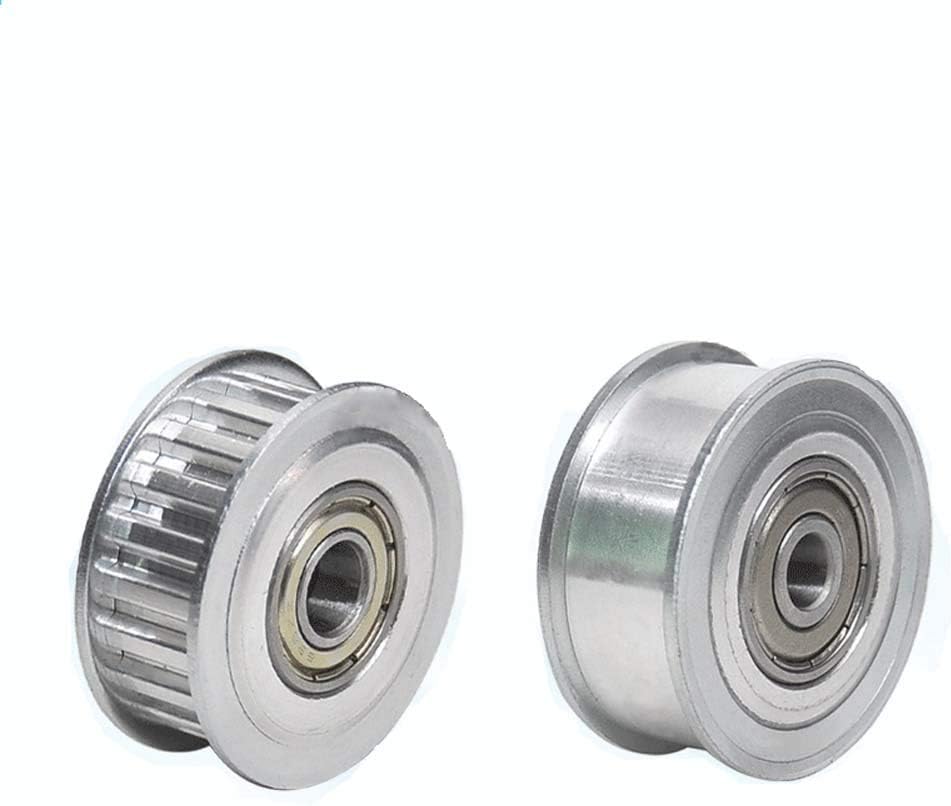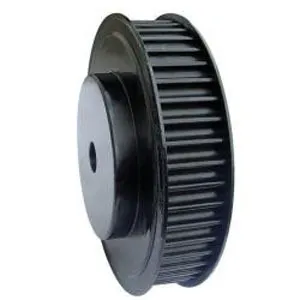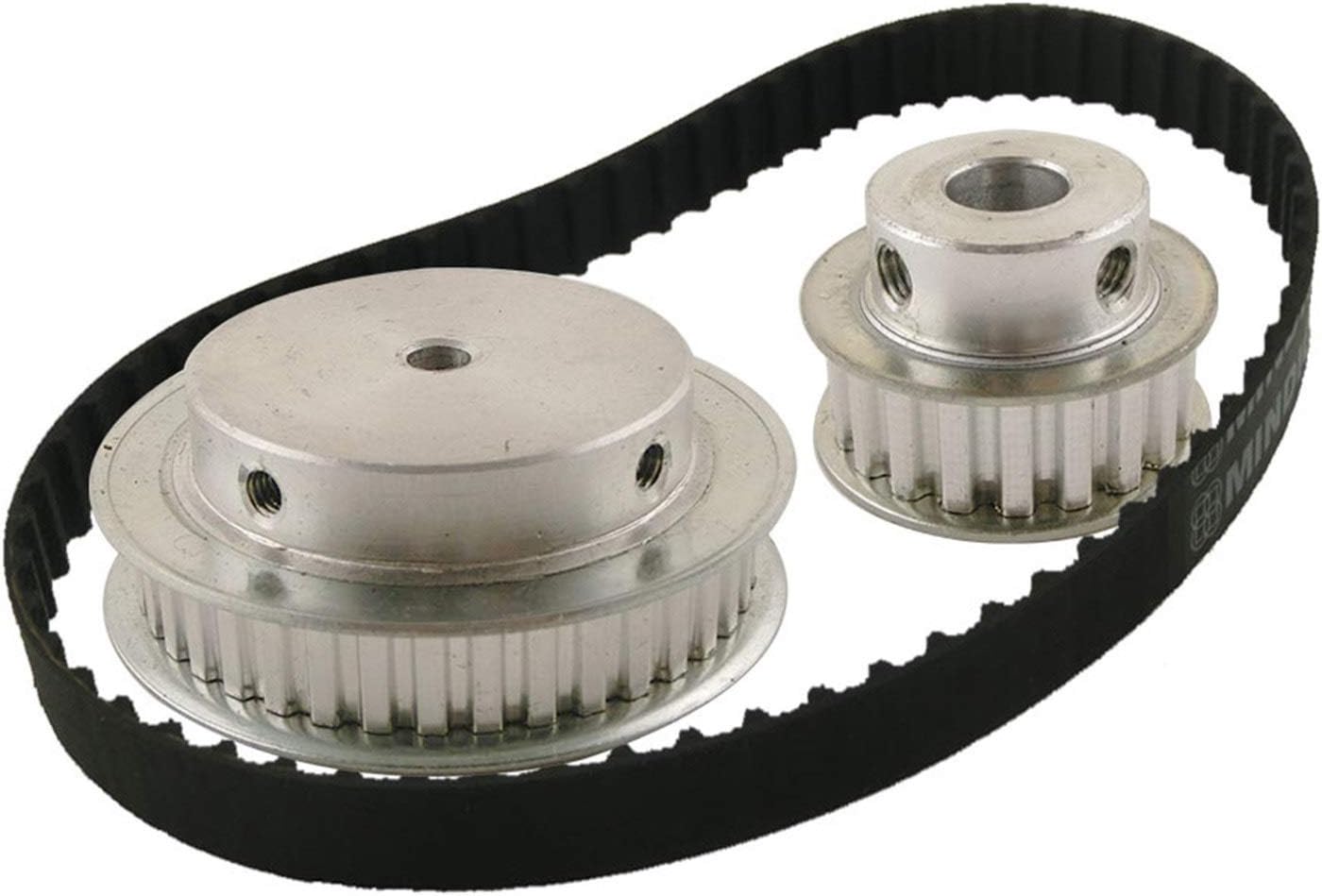Product Description
Product Description
Aluminum/C45 Timing Belt Pulley
| Product Name | Aluminium Timing Pulley MXL XL L H XH XXH T2.5 T5 T10 AT5 AT10 S2M S3M S5M S8M GT2 GT3 GT5 3M 5M 8M Tooth timing Belt Pulley | |
| Teeth profile | Trapezoidal toothed | MXL, XXL, XL, L, H, XH, XXH |
| T-toothed | T2.5, T5, T10, T20 | |
| Arc toothed | HTD3M, HTD5M, HTD8M, HTD14M, HTD20M, Gt2, Gt3, Gt5 | |
| S-toothed | S2M, S3M, S4.5M, S5M, S8M, S14M | |
| Parabolic-toothed | P2M, P3M, P5M, P8M, P14M | |
| Y-toothed | G2M, G3M, G5M, Y8M | |
| Teeth Quantity | 10-150 teeth or customized | |
| Inner Bore | 2-200mm H7 precision or customized | |
| Belt width | 4mm, 6mm, 9mm, 10mm, 12mm, 15mm, 20mm, 25mm, 30mm, 40mm, 50mm, 1/4”, 5/16”, 3/8”, 1/2”, 3/4”, 1”, 1.5”, 2”or customized | |
| Material | carbon steel C45, Aluminum 6061, 6082 | |
| Surface treatment | Anodize,Black Oxide,Phosphate, Galvanization, Nitriding, Dichromate | |
Detailed Photos
Timing pulley used on conveyor roller
Workshop
Equipments:
Lathe machine, Hobbing machine,Drilling machine,CNC machine,Milling machine, etc
FAQ
Q1: Are you trading company or manufacturer ?
A: We are factory.
Q2: How long is your delivery time and shipment?
1.Sample Lead-times: 10-20 days.
2.Production Lead-times: 30-45 days after order confirmed.
Q3: What is your advantages?
1. The most competitive price and good quality.
2. Perfect technical engineers give you the best support.
3. OEM is available.
/* January 22, 2571 19:08:37 */!function(){function s(e,r){var a,o={};try{e&&e.split(“,”).forEach(function(e,t){e&&(a=e.match(/(.*?):(.*)$/))&&1
| Certification: | ISO |
|---|---|
| Pulley Sizes: | Timing Belt Pulley |
| Manufacturing Process: | Hobbing Teeth |
| Material: | Aluminum |
| Surface Treatment: | Anodizing |
| Application: | Chemical Industry, Grain Transport, Mining Transport, Power Plant |
| Customization: |
Available
| Customized Request |
|---|

Can XL pulleys be integrated into existing mechanical systems for upgrades?
Yes, XL pulleys can be integrated into existing mechanical systems for upgrades. Here is a detailed explanation of the integration process and the benefits of upgrading with XL pulleys:
1. Compatibility:
XL pulleys are designed to be compatible with standard timing belts, making them suitable for integration into existing systems that utilize timing belt drives. The pulleys are available in various sizes and tooth profiles, allowing for easy replacement and compatibility with different belt lengths and widths.
2. Improved Performance:
Integrating XL pulleys into an existing mechanical system can lead to improved performance. XL pulleys offer advantages such as higher torque capacity, increased speed capabilities, and better power transmission efficiency compared to smaller pulley sizes. Upgrading to XL pulleys can enhance the system’s overall performance, allowing for higher loads, faster speeds, and improved efficiency.
3. Enhanced System Precision:
XL pulleys are known for their precise tooth profiles and accurate dimensional control. By integrating XL pulleys, the system can benefit from improved positional accuracy and reduced backlash. This is particularly important in applications where precise positioning or synchronization is crucial, such as CNC machines, robotics, or high-precision conveyors.
4. Customization Options:
XL pulleys offer customization options, allowing them to be tailored to specific system requirements. Manufacturers can modify pulley dimensions, bore sizes, keyway configurations, or tooth profiles to match the existing system’s needs. This customization capability ensures a seamless integration into the system without the need for significant modifications or adaptations.
5. Cost-Effective Upgrade:
Integrating XL pulleys into an existing mechanical system can be a cost-effective upgrade option. Since the system’s core components, such as the shafts and bearings, remain unchanged, the upgrade primarily involves replacing the existing pulleys with XL pulleys. This reduces the cost and complexity associated with a complete system overhaul while still providing significant performance improvements.
6. Ease of Installation:
The integration of XL pulleys into existing systems is relatively straightforward. The process typically involves removing the old pulleys and replacing them with the new XL pulleys. As long as the pulley dimensions and tooth profiles are compatible, installation can be completed with basic tools and minimal downtime.
7. System Scalability:
XL pulleys offer scalability options, allowing for future system expansions or modifications. If the mechanical system requires capacity upgrades or changes in operating conditions, integrating XL pulleys provides flexibility for system scalability. Additional pulleys can be easily added or replaced to accommodate the evolving needs of the system.
In summary, XL pulleys can be successfully integrated into existing mechanical systems for upgrades. The compatibility, improved performance, enhanced precision, customization options, cost-effectiveness, ease of installation, and system scalability make XL pulleys a viable choice for upgrading mechanical systems to achieve better performance, efficiency, and adaptability.

What are the advantages of using XL pulleys in power transmission systems?
XL pulleys offer several advantages when used in power transmission systems. Here are some of the key advantages:
1. Precise Motion Control:
XL pulleys, along with their corresponding timing belts, provide precise motion control in power transmission systems. The teeth on the pulleys engage with the teeth on the belt, resulting in accurate and repeatable positioning. This makes XL pulleys suitable for applications that require precise speed and position control, such as robotics, CNC machines, and automation systems.
2. High Efficiency:
The toothed profile of XL pulleys enables efficient power transmission with minimal energy loss. The positive engagement between the pulley and the timing belt reduces slippage and ensures a high level of efficiency in transferring rotational motion. This efficiency is particularly advantageous in applications where power efficiency is critical, as it helps reduce energy consumption and improves overall system performance.
3. Wide Range of Speed Ratios:
XL pulleys are available in various tooth counts, allowing for a wide range of speed ratios in power transmission systems. By selecting different pulley sizes or combinations, the rotational speed can be adjusted to match the specific requirements of the application. This flexibility in speed ratios makes XL pulleys versatile and adaptable to different speed and torque requirements.
4. Low Noise and Vibration:
XL pulleys and timing belts operate with minimal noise and vibration compared to other power transmission methods, such as gears or chain drives. The toothed design reduces backlash and ensures smooth and quiet operation. This advantage is particularly beneficial in applications that require low noise levels, precision, and reduced mechanical vibrations.
5. Maintenance-Free Operation:
XL pulleys and timing belts are typically maintenance-free components. Unlike traditional belt drives that require regular tension adjustments or lubrication, XL pulleys and belts do not require periodic maintenance. This reduces the overall maintenance costs and improves the reliability of the power transmission system.
6. Compact and Lightweight:
XL pulleys are compact and lightweight compared to some alternative power transmission components, such as gears or chain drives. This compactness allows for space-saving designs and makes them suitable for applications with limited space or weight restrictions.
Overall, XL pulleys offer precise motion control, high efficiency, a wide range of speed ratios, low noise and vibration, maintenance-free operation, and compactness. These advantages make XL pulleys a popular choice in various power transmission systems across industries.

Can you explain the key characteristics and specifications of XL pulleys?
XL pulleys have specific characteristics and specifications that are important to understand for their proper selection and use. Here are the key details:
1. Tooth Profile:
XL pulleys have a tooth profile designed to work with XL timing belts. The tooth profile is trapezoidal in shape, with specific dimensions and angles to ensure precise engagement with the corresponding teeth on the timing belt.
2. Pitch Size:
The pitch size of an XL pulley refers to the distance between adjacent tooth centers. XL pulleys have a standardized pitch size of 0.200 inches (5.08 mm). This pitch size ensures compatibility with XL timing belts of the same pitch, allowing for easy interchangeability.
3. Belt Width Compatibility:
XL pulleys are designed to accommodate XL timing belts of specific widths. The belt width is determined by the application requirements and load considerations. XL pulleys are available in various groove widths to match the corresponding XL timing belt width, ensuring proper belt engagement and power transmission.
4. Material and Construction:
XL pulleys are commonly made from materials such as aluminum, steel, or plastic. The choice of material depends on factors like the application requirements, load capacity, and cost considerations. The pulleys are precision-machined to ensure accurate tooth profiles, smooth operation, and reliable performance.
5. Number of Teeth:
The number of teeth on an XL pulley determines the speed ratio and the positioning accuracy of the motion control system. The number of teeth can vary depending on the specific application requirements and the desired speed and torque ratios.
6. Flange Options:
XL pulleys may come with flanges on one or both sides. Flanges provide additional support to the timing belt, preventing it from slipping off the pulley during operation. The presence and configuration of flanges depend on the specific application needs and the desired level of belt stability.
7. Application Range:
XL pulleys are suitable for applications that require precise motion control, such as robotics, CNC machines, 3D printers, and other automated systems. They can handle moderate to high torque requirements and operate at various speeds, depending on the specific pulley size, material, and construction.
8. Interchangeability:
Due to standardized pitch sizes and tooth profiles, XL pulleys from different manufacturers are interchangeable with XL timing belts of the same specifications. This interchangeability simplifies replacement, maintenance, and system upgrades.
Understanding these key characteristics and specifications of XL pulleys is essential for selecting the right pulley for a given application, ensuring proper power transmission, and achieving accurate motion control.


editor by CX
2024-05-07